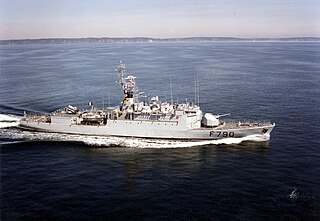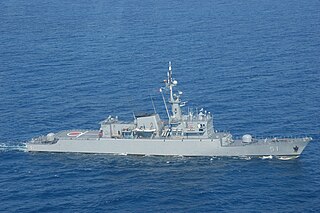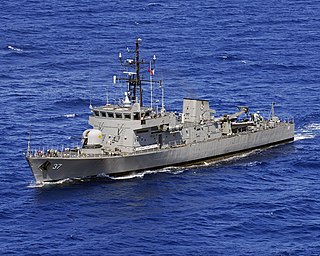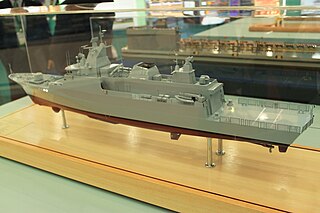
The Anzac class is a ship class of ten frigates; eight operated by the Royal Australian Navy (RAN) and two operated by the Royal New Zealand Navy (RNZN). During the 1980s, the RAN began plans to replace the River-class destroyer escorts with a mid-capability patrol frigate, and settled on the idea of modifying a proven German design for Australian conditions. Around the same time, the RNZN was seeking to replace their Leander-class frigates while maintaining blue-water capabilities. A souring of relations between New Zealand and the United States of America in relation to New Zealand's nuclear-free zone and the ANZUS security treaty prompted New Zealand to seek improved ties with other nations, particularly Australia. As both nations were seeking warships of similar capabilities, the decision was made in 1987 to collaborate on their acquisition. The project name is taken from the Australian and New Zealand Army Corps of the First World War.

The Royal Malaysian Navy is the naval arm of the Malaysian Armed Forces. RMN is the main agency responsible for the country's maritime surveillance and defense operations. RMN's area of operation consists of 603,210 square kilometers covering the country's coastal areas and Exclusive Economic Zones (EEZ). RMN also bears the responsibility of controlling the country's main Sea Lines of Communications (SLOC) such as the Straits of Malacca and the Straits of Singapore and also monitors national interests in areas with overlapping claims such as in Spratly.

The D'Estienne d'Orves-class avisos, also known as the A69 type avisos, is a class of avisos, comparable in size to a light corvette, mainly designed for coastal anti-submarine defence, but are also available for high sea escort missions. Built on a simple and robust design, they have an economical and reliable propulsion system which allows them to be used for overseas presence missions. They were initially intended for use by the French Navy, but have been ordered by the South African Navy, Argentinian Navy and Turkish Navy.

A stealth ship is a ship which employs stealth technology construction techniques in an effort to ensure that it is harder to detect by one or more of radar, visual, sonar, and infrared methods.

The Almirante Padilla-class frigates is a series of frigates operated by the Colombian Navy. The designation of this class is Type FS 1500 and there are four ships in service. The ships were built by Howaldtswerke-Deutsche Werft (HDW) at Kiel, West Germany in the 1980s, with the first vessel commissioning in 1983 and the last in 1984. The frigates have undergone significant modification over their careers with the 2012 Orion Program Upgrade significantly modernising the vessels. Two similar ships operate as the Kasturi-class corvettes in the Royal Malaysian Navy.

The Kedah-class offshore patrol vessels of the Royal Malaysian Navy (RMN) are six ships based on the MEKO 100 design by Blohm + Voss. Originally, a total of 27 ships were planned, but due to programme delays and overruns, only six were eventually ordered. Their construction began in the early 2000s, and by 2009, all six were in active service. The six vessels are named after Malaysian states.

BRP Artemio Ricarte (PS-37) is third ship of the Jacinto-class corvettes currently assigned to the Offshore Combat Force of the Philippine Fleet. She is one of few ships in the Philippine Navy equipped with modern systems after the completion of combat, navigation and weapon systems upgrade of her class in August 2019. She was originally called HMS Starling (P241) during her service with the Royal Navy.

The Durango class is an offshore patrol vessel class in service with the Mexican Navy. The Durango class, comprising four ships, was designed and constructed in Mexico in 1999–2000. The class entered service in 2000 and is used primarily for drug interdiction and patrol.

The Sierra-class corvettes are corvettes of the Mexican Navy intended mainly for interception of drug smugglers, exclusive economic zone (EEZ) patrol, and countering terrorism. The class comprises four ships with the lead ship ARM Sierra commissioned by the Mexican Navy in 1998. One ship, ARM Benito Juárez, was sunk as a target ship in 2007 after being wrecked by fire in 2003. The other three vessels remain in service.

The BRP Apolinario Mabini (PS-36) is the second ship of the Jacinto-class corvettes currently assigned to the Offshore Combat Force of the Philippine Fleet. She is one of few ships in the Philippine Navy equipped with modern systems after the completion of combat, navigation and weapon systems upgrade of her class in August 2019. She is named after Apolinario Mabini, a hero of the Philippine revolution and a former prime minister. She was originally called HMS Plover (P240) during her service with the Royal Navy.

The Lerici class is a class of minehunters constructed by Intermarine SpA and owned and operated by the Italian Navy. The class incorporates two subclasses: the first four ships are referred to specifically as the first series of the Lerici class, while eight more ships produced to a slightly modified design are known as "second series Lericis" or as the Gaeta class.
The Khamronsin-class corvettes are three corvettes constructed for the Royal Thai Navy in the late 1980s. Based on a British design, all three ships were built in Thailand. A fourth vessel, constructed to a modified design, was built for the Thai Police and was the first to enter service in 1992. The three Khamrosin-class corvettes commissioned in 1992 and remain in service.

The Ratanakosin-class corvettes are a class of two corvettes that were built for the Royal Thai Navy in the 1980s. Constructed in the United States, a third was planned to be built in Thailand, but was canceled before construction could begin. The Ratanakosin class is used as flagships for squadrons of fast attack craft. Both ships remain in service.

The Moroccan frigate Mohammed V is a Floréal-class frigate of the Royal Moroccan Navy. The ship was the first to be constructed for Morocco by Chantiers de l'Atlantique at Saint-Nazaire, France from 1999 to 2001. The frigate entered service in 2002. Mohammed V is the first of two Floréal-class frigates in Moroccan service, the other being Hassan II.

The Moroccan frigate Hassan II is a Floréal-class frigate of the Royal Moroccan Navy. The ship was the first to be constructed for Morocco by Chantiers de l'Atlantique at Saint-Nazaire, France from 1999 to 2002. The frigate entered service in 2002. Hassan II is the second of two Floréal-class frigates in Moroccan service, the other being Mohammed V.

KD Kedah (F171) is the lead ship of Kedah-class offshore patrol vessel of the Royal Malaysian Navy. She was commissioned on 5 June 2006.

KD Pahang (F172) is the second ship of Kedah-class offshore patrol vessel of the Royal Malaysian Navy. She was commissioned on 3 August 2006.

KD Perak (F173) is the third ship of Kedah-class offshore patrol vessel of the Royal Malaysian Navy. She was commissioned on 3 June 2009.

KD Terengganu (F174) is the fourth ship of Kedah-class offshore patrol vessel of the Royal Malaysian Navy. She was commissioned on 8 December 2009.

KD Selangor (F176) is the sixth ship of Kedah-class offshore patrol vessel of the Royal Malaysian Navy. She was commissioned on 28 December 2010.


















